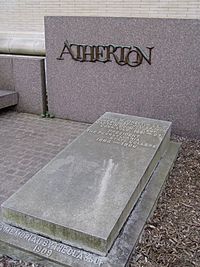George W. Atherton facts for kids
Quick facts for kids
George W. Atherton
|
|
|---|---|

Atherton pictured in La Vie 1908, Penn State yearbook
|
|
| 7th President of the Pennsylvania State University | |
| In office 1882–1906 |
|
| Preceded by | James Y. McKee |
| Succeeded by | James A. Beaver |
| Personal details | |
| Born | June 20, 1837 Boxford, Massachusetts, US |
| Died | July 24, 1906 (aged 69) State College, Pennsylvania, US |
| Spouse | Frances W. Atherton |
| Alma mater | Yale University |
George Washington Atherton (June 20, 1837 – July 24, 1906) was an important American soldier and educator. He served as the president of Pennsylvania State University (Penn State) from 1882 until he passed away in 1906. He helped transform the school into a major university.
Contents
Early Life and Family
George W. Atherton was born on June 20, 1837. His father, Hiram Atherton, died when George was only nine years old. To help his mother, Almira Gardner, George worked on a farm and in a cotton mill. His family were early settlers in Massachusetts.
Military Service in the Civil War
In 1861, Atherton joined the Union Army during the American Civil War. He became a captain in the 10th Regiment Connecticut Volunteer Infantry. He led his company in important battles like the Battle of Roanoke Island and the Battle of New Bern. He left the army in June 1863 due to health reasons.
Education and Early Career
Atherton was a dedicated student. He attended Topsfield Academy and Philips Exeter Academy. He then graduated from Yale University in 1863.
After college, Atherton started teaching. He taught at The Albany Academy in Albany, New York. Later, he taught at the University of Illinois. He then became a political science professor at Rutgers University.
Leading Penn State University
Atherton became the seventh president of Penn State in 1882. At that time, the school was mainly an agricultural college. It was not very well known. Atherton faced the big challenge of turning it into a respected "land-grant" college. Land-grant colleges were created to teach practical subjects like agriculture and engineering.
During his 24 years as president, Penn State grew a lot. In 1882, only seven students graduated. By 1906, when he died, 86 students graduated. He was seen as a visionary leader. He helped the school become a strong institution for technical education.
Focus on Technical Education
When Atherton became president, the government of Pennsylvania was unsure about Penn State. They did not want to give it much money. Atherton worked hard to improve the school's image. He believed Penn State should focus on technology and engineering. This was in line with the Morrill Land-Grant Colleges Act.
However, Governor Robert E. Pattison thought the school should only teach agriculture. In 1884, the school's board of trustees supported Atherton's vision. This allowed him to continue building a strong technical education program. He wanted to provide affordable education that would help Pennsylvania's industries.
Atherton also helped create the Hatch Act of 1887. This act provided federal funding for agricultural experiment stations. This helped research in farming.
He greatly improved the engineering programs. He got money from the Pennsylvania assembly to build more buildings. By 1893, most of the students were studying engineering. This showed how important industrialization was in Pennsylvania. By 1900, Penn State's engineering program was one of the top ten in the country.
Changes to Courses and Learning

Atherton also worked to improve other subjects, like liberal arts. New programs in ancient languages and philosophy were started. He also supported expanding the library. In 1899, Andrew Carnegie donated money for the library.
In 1895, Atherton grouped similar subjects into seven different colleges. This helped organize the school better. He also started other learning programs. These included short courses, online courses, and summer school. By the time he died, enrollment had grown to 800 students. Most of them were studying for bachelor's degrees.
Student Life at Penn State
Under Atherton, student activities grew a lot. Sports programs began to develop. In 1892, he hired a physical training director. He also approved building Beaver Field for sports.
Students started a newspaper called The Free Lance. The first yearbook was also published. The Blue Band was formed in 1899. New theater and music groups also began.
Atherton kept good discipline among students. All male students had to attend classes and get military training. This was part of the land-grant act rules. Even so, students liked Atherton. He was known for listening fairly to their concerns. In 1888, he approved the first fraternities at the university. He also changed the school schedule based on student wishes.
Personal Life and Legacy
George W. Atherton married Frances "Fannie" Wright Darusmont Washburn in 1863. They had six children. Their youngest son, Charles Morgan Herbert, became a Major League Baseball player.
Atherton passed away in Harrisburg, Pennsylvania, in 1906. He is buried on the campus of Penn State. His grave is near Schwab Auditorium and Old Main.
Images for kids


